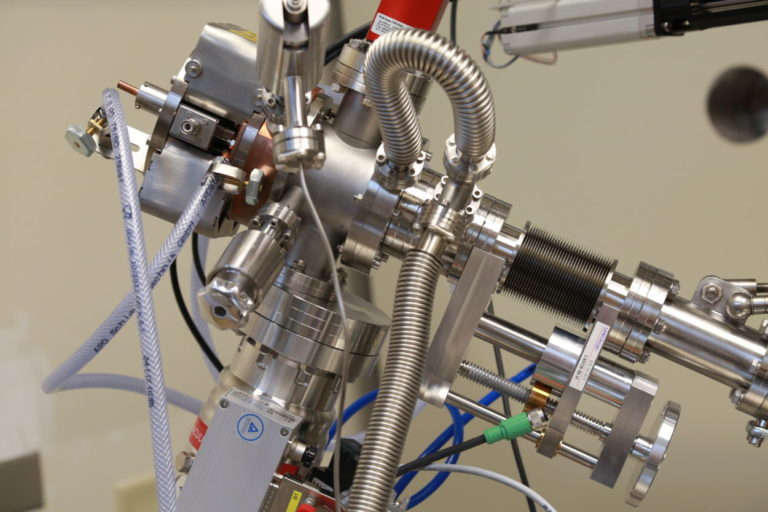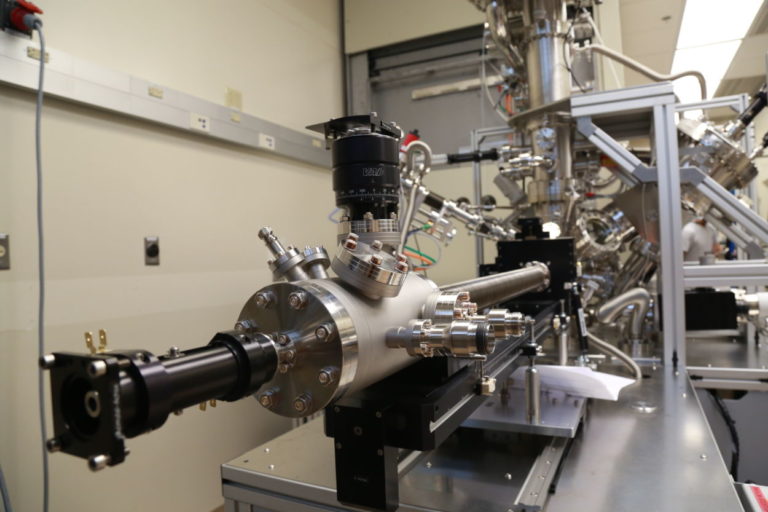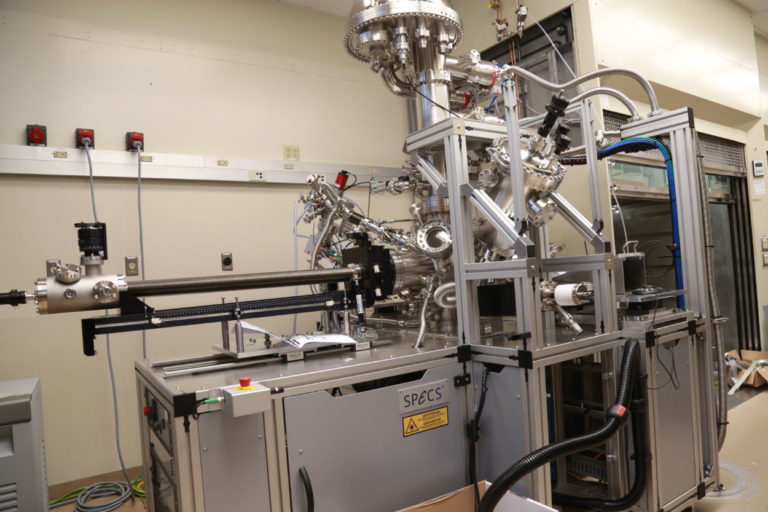RDECOM ECBC Expands Capability for Agent-Surface Analysis
RDECOM ECBC Expands Capability for Agent-Surface Analysis
Shawn Nesaw
A new cutting-edge analytical instrument will grant researchers at the U.S. Army Research, Development and Engineering Command Edgewood Chemical Biological Center (RDECOM ECBC) the ability to develop highly advanced materials integral to defense technologies including surface coatings, filters and textiles that will better protect the warfighter from chemical threats.
The multisystem will be used to investigate the interaction of chemical warfare agents with the surface of protective materials at the molecular level.
Rather than using one analytical technique, the multisystem uses a combination of near-ambient pressure X-ray photoelectron spectroscopy (NAP-XPS), ultraviolet photoelectron spectroscopy, infrared reflection absorption spectroscopy and mass spectrometry techniques.
The four techniques are incorporated into a single multisystem instrument granting scientists the ability to identify reaction products and follow the chemistry occurring on the surface of materials in real time. The system provides a unique suite of techniques to reveal the surface reaction mechanisms integral for developing advanced materials.
By testing agent reactions at near-ambient pressures, we’re able to simulate real-world conditions, most closely related to what the warfighter may experience.”RDECOM ECBC Research Chemist Wes Gordon, Ph.D.
Research chemist Monica McEntee, Ph.D., managed the technical design, installation and future use of the system, emphasized, “In order to solve difficult scientific questions, one technique is not enough,” she said. “Each component of this system will give a new piece of information that will be combined to provide a solid understanding of the interactions between chemical threats and surfaces in real time.”
The XPS component measures the number of electrons emitted when special X-rays are applied to a sample, providing detailed information about the elemental composition and state of the agent before and after a reaction has occurred. While most XPS instruments require ultra-high vacuum conditions, this system can measure data in real time during a reaction at near-ambient pressures, similar to environmental conditions that the warfighter might experience on the battlefield. This capability is important to scientists like Wes Gordon, Ph.D., as they strive to understand how chemical agents behave in the field.
“By testing agent reactions at near-ambient pressures, we’re able to simulate agent reactions under real-world conditions, most closely related to what the warfighter may experience,” explained Gordon.
The multi-technique system will be used to analyze coatings, paints and other advanced surfaces for military equipment such as tanks, aircraft, weapon systems and even uniforms, to determine if the coating’s surface is resistant to chemical agent. Beyond coatings, the system will analyze emerging filtration and decontamination materials such as zirconium hydroxide and metal organic frameworks to help understand how chemical warfare agents and battlefield contaminants interact with materials of interest.
For example, when a material is exposed to sarin nerve agent, the system can analyze the agent breakdown on the material at the molecular level in real time, informing scientists exactly what elements are left on the surface, the oxidation state of the elements and the types of chemical bonds formed after a chemical reaction.
That means a lot to research chemist Erin Durke, Ph.D, who can then apply what she’s learned from the analysis to modify the material to make it better and more effective at protecting the warfighter. “We can see how agent molecules break down to determine our next steps for improving material design,” explained Durke.



Rather than using one analytical technique, the multisystem uses a combination of near-ambient pressure X-ray photoelectron spectroscopy (NAP-XPS), ultraviolet photoelectron spectroscopy, infrared reflection absorption spectroscopy and mass spectrometry techniques.
To secure the funding, contract the best company to design and develop the system, and manage installation, Chemical Biological and Radiological Filtration Branch Chief Amy Maxwell and a group of experienced surface scientists and technicians worked closely with the Defense Threat Reduction Agency’s (DTRA) Joint Science and Technology Office (JSTO) and the Government Services Administration for two years.
With part of its mission to innovate capability solutions, DTRA JSTO saw an opportunity to solve a capabilities gap and provided the funding necessary to bring the specialized multicomponent system project to fruition. DTRA JSTO is a driving force in the surface science field, moving many applications from basic science to more applied science to ultimately help the warfighter.
From an Army modernization and priorities perspective, the system capability aligns with goals to create next-generation combat vehicles and enhance Soldier lethality as it supports the development of new, advanced materials for coatings, filters and protective fabrics. Beyond that, the system will also allow scientists to determine basic properties and the reactive nature of advanced materials allowing for the more efficient design and development of protective technologies.
The RDECOM ECBC team will take the next year to run calibration, small molecule and simulant tests to optimize the system to its full potential. Simulant tests consist of research using chemicals similar to chemical agents without the toxic potency. Once their year of simulant testing is complete, then the system will begin testing with chemical agent.
RDECOM ECBC looks forward to sharing the highly specialized capability with other institutions, businesses and customers.
“The level of detail we will receive from the NAP-XPS is unmatched,” Maxwell said. “The NAP-XPS increases the Center’s surface science capabilities and also provides increased opportunity to help others. We’re looking forward to some amazing collaborations in the future with national laboratories, universities, organizations and companies who can utilize the system’s data and capabilities to further their research.”
The multifunctional NAP-XPS system was recently installed at RDECOM ECBC.

